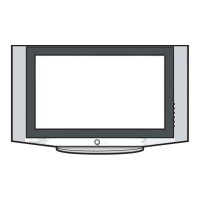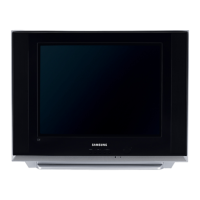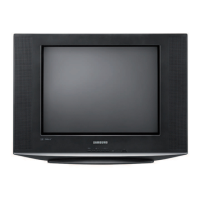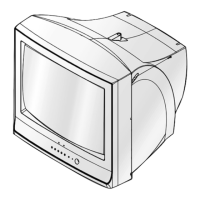Do you have a question about the Samsung CS29Z30 and is the answer not in the manual?
Lists items included with the TV, such as remote control and batteries.
Describes the buttons and indicators on the TV's front panel for operation.
Details the various input/output ports on the rear and side of the TV for connecting devices.
Explains the function of each button on the remote control for TV operation.
Instructions for switching the television on, off, and into standby mode.
Explains how to place the TV in standby mode to save power and interrupt viewing.
Guides through the automatic initial setup for language, channel, and clock.
How to choose and display signals from connected external devices.
Allows users to assign custom names to connected external sources for easier identification.
Scans available frequency ranges to automatically store TV channels.
Manually stores channels by selecting program number, color system, and sound system.
Excludes specific channels from being displayed during scanning or channel surfing.
Rearranges the program numbers of stored channels into a desired numerical order.
Assigns custom names to channels for easier identification and selection.
Manually adjusts channel reception for sharper picture and better sound quality.
Selects the picture type that best matches viewing requirements (Dynamic, Standard, etc.).
Amplifies weak TV signals using a low-noise preamplifier for better reception.
Fine-tunes contrast, brightness, sharpness, and color for optimal picture quality.
Adjusts the picture size (e.g., 4:3, 16:9, Zoom) to fit the screen requirements.
Reduces static and ghosting on screen, especially with weak signal reception.
Demonstrates the Digital Natural Image engine (DNIe) by showing applied vs. normal picture.
Adjusts the picture tilt if it appears slightly slanted on the screen.
Automatically senses and processes film signals for optimum picture quality.
Displays a sub picture within the main picture for simultaneous viewing of multiple sources.
Selects the video source for the main and sub pictures in PIP mode.
Swaps the main and sub picture content or changes the size and position of the sub picture.
Pauses the current TV program, allowing for a still image display.
Selects different sound effect types for broadcasts (Standard, Music, Movie, Speech).
Fine-tunes equalizer settings for bass, mid, and treble to customize audio output.
Configures SRS TruSurround XT, Auto Volume, Turbo Sound, and Pseudo Stereo for enhanced audio.
Chooses the audio mode (Mono, Stereo, Dual I/II) based on broadcast type and signal quality.
Sets the television's internal clock for accurate time display and timer functions.
Sets a timer for the TV to automatically turn off after a specified period.
Schedules the TV to switch on or off automatically at a set time and channel.
Chooses the display language for menus, indications, and system messages.
Controls whether a blue screen is displayed instead of noisy pictures with weak signals.
Enables or disables a melody sound played when the television is powered on or off.
Explains how to activate, navigate, and use various teletext functions and buttons.
Instructions for degaussing the picture tube to remove color patches.
Provides simple checks for common issues like no sound, no picture, or interference.
| Type | CRT TV |
|---|---|
| Aspect Ratio | 4:3 |
| Display Size | 29 inches |
| Screen Type | Flat |
| Input Ports | Composite |












